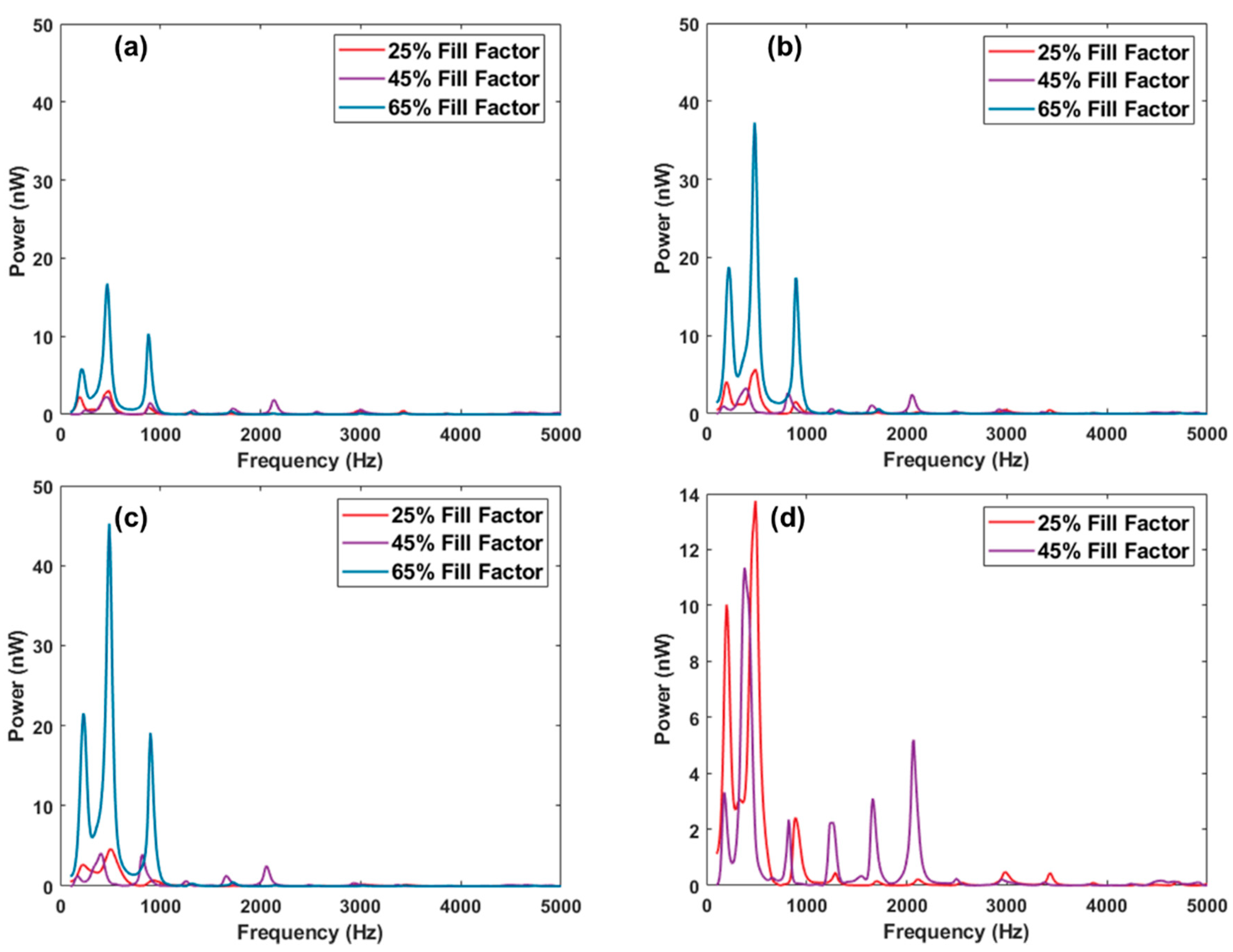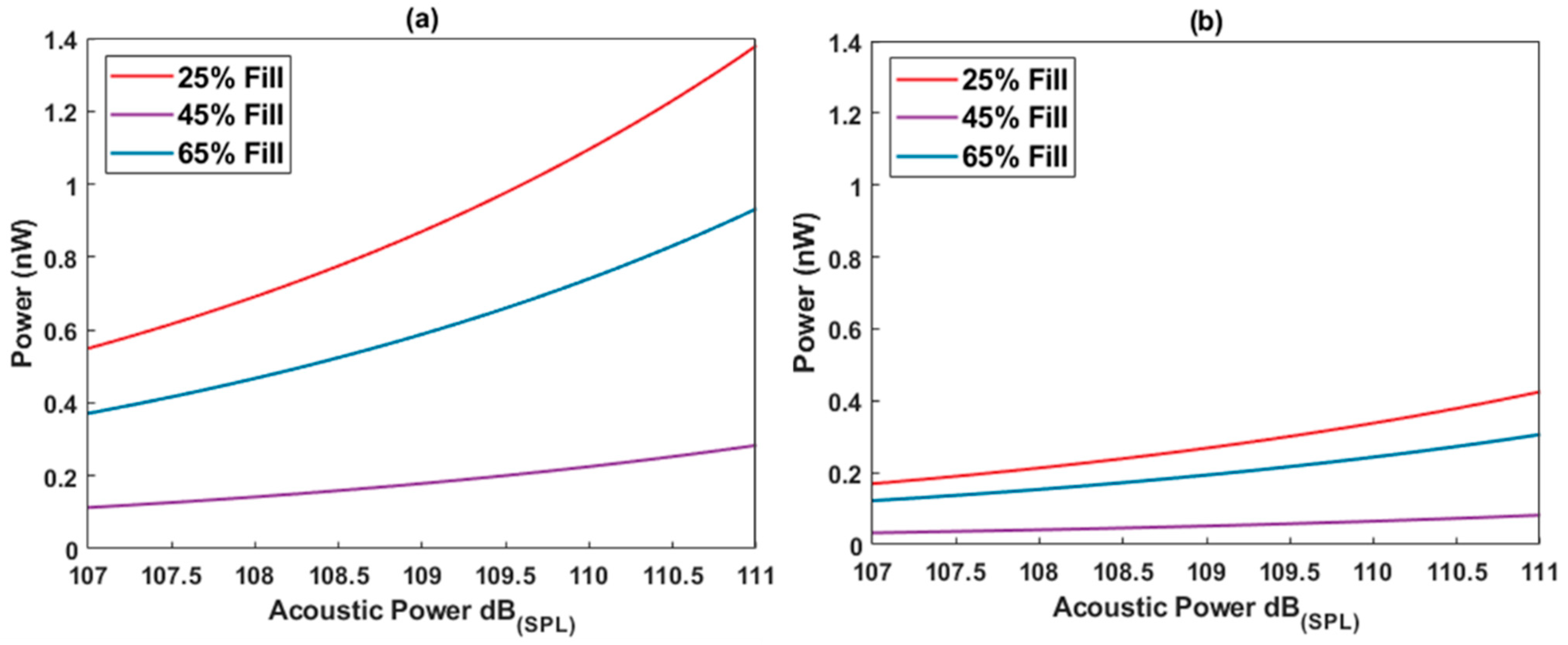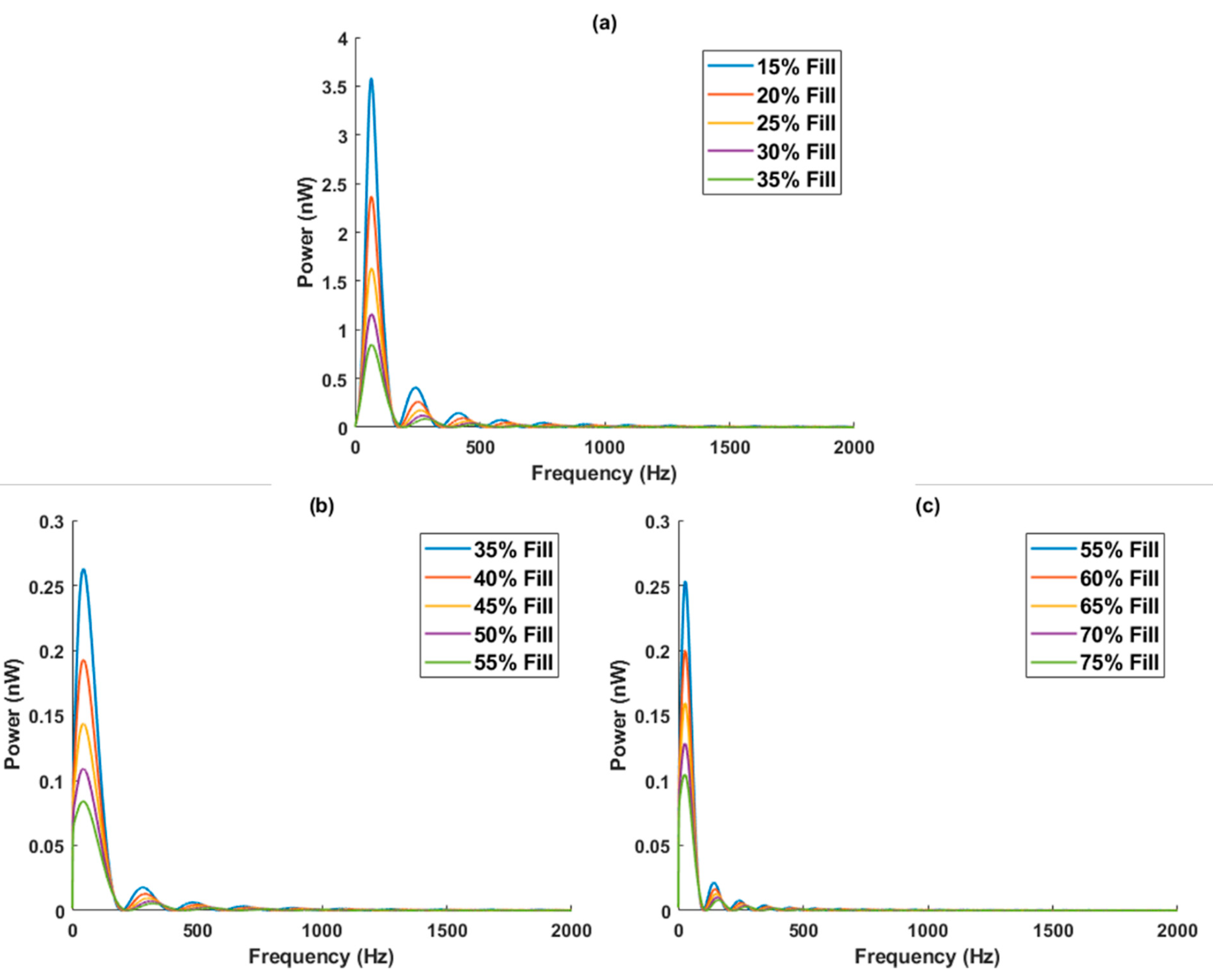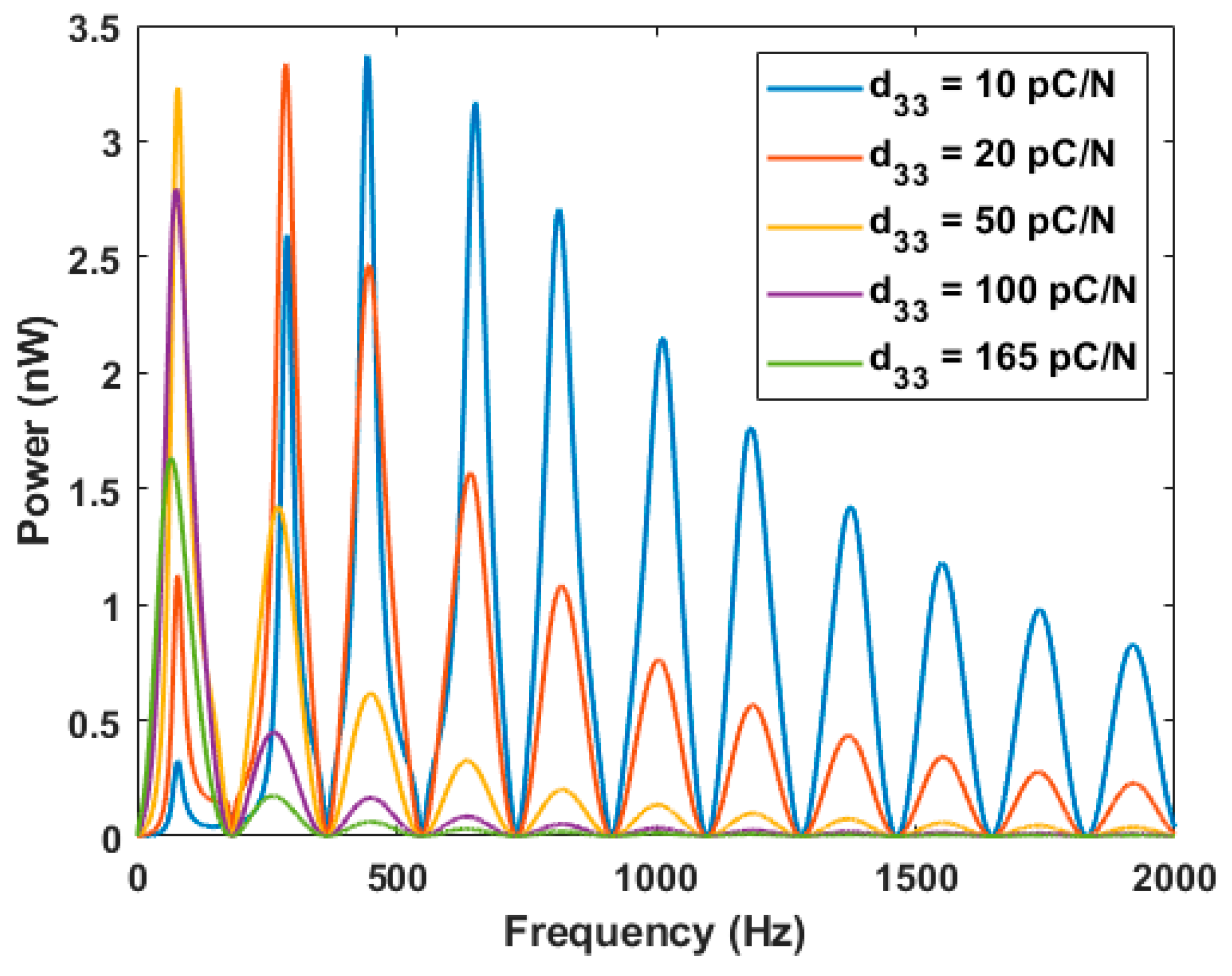Acoustic Energy Harvesting of Piezoelectric Ceramic Composites
Abstract
:1. Introduction
2. Materials and Methods
2.1. Absorption Coefficient Measurement
2.2. Power Generation Measurement
2.3. Sample Details
2.4. Model Details/Equivalent Circuit Design
3. Results
3.1. Absorption Coefficient of PZT Ceramics
3.2. Power Generated
3.3. KLM Model Results
4. Discussion
5. Conclusions
Supplementary Materials
Author Contributions
Funding
Data Availability Statement
Conflicts of Interest
References
- Yuan, M.; Cao, Z.; Luo, J.; Chou, X. Recent Developments of Acoustic Energy Harvesting: A Review. Micromachines 2019, 10, 48. [Google Scholar] [CrossRef] [PubMed] [Green Version]
- Khan, F.U. Izhar State of the art in acoustic energy harvesting. J. Micromech. Microeng. 2015, 25, 023001. [Google Scholar] [CrossRef]
- Marakakis, K.; Tairidis, G.K.; Koutsianitis, P.; Stavroulakis, G.E. Shunt piezoelectric systems for noise and vibration control: A review. Front. Built Environ. 2019, 5, 64. [Google Scholar] [CrossRef]
- Makihara, K.; Miyakawa, T.; Onoda, J.; Minesug, K.I. Fuselage panel noise attenuation by piezoelectric switching control. Smart Mater. Struct. 2010, 19, 085022. [Google Scholar] [CrossRef]
- Larbi, W.; Deu, J.-F.; Ohayon, R. Finite element reduced order model for noise and vibration reduction of double sandwich panels using shunted piezoelectric patches. Appl. Acoust. 2016, 108, 40–49. [Google Scholar] [CrossRef]
- Hui-ye, Y.; Yang, L.; Chong, D.; Yi-Fan, Q.; Jin-Chao, M.; Tian-Yu, Z. Study on Electrical Parameter Matching of Piezoelectric Stack Periodic Strut for Helicopter Cabin Noise Control. Shock. Vib. 2022, 2022, 8952217. [Google Scholar] [CrossRef]
- Liu, F.; Phipps, A.; Horowitz, S.; Ngo, K.; Cattafesta, L.; Nishida, T.; Sheplak, M. Acoustic energy harvesting using an electromechanical Helmholtz resonator. J. Acoust. Soc. Am. 2008, 123, 1983–1990. [Google Scholar] [CrossRef]
- Horowitz, S.B.; Sheplak, M.; Cattafesta, L.N.; Nishida, T. A MEMS acoustic energy harvester. J. Micromech. Microeng. 2006, 16, S174–S181. [Google Scholar] [CrossRef]
- Liu, G.-S.; Peng, Y.-Y.; Liu, M.-H.; Zou, X.-Y.; Cheng, J.-C. Broadband acoustic energy harvesting metasurface with coupled Helmholtz resonators. Appl. Phys. Lett. 2018, 113, 153503. [Google Scholar] [CrossRef] [Green Version]
- Li, H.Y.; Choi, B. A multilayer PVDF composite cantilever in the Helmholtz resonator for energy harvesting from sound pressure. Smart Mater. Struct. 2013, 22, 115025. [Google Scholar]
- Li, B.; You, J.H.; Kim, Y.-J. Low frequency acoustic energy harvesting using PZT piezoelectric plates in a straight tube resonator. Smart Mater. Struct. 2013, 22, 055013. [Google Scholar] [CrossRef]
- Yuan, M.; Cao, Z.; Luo, J.; Zhang, J.; Cheng, C. An efficient low-frequency acoustic energy harvester. Sens. Actuators A 2017, 264, 84–89. [Google Scholar] [CrossRef]
- Qi, S.; Oudich, M.; Li, Y.; Assouar, B. Acoustic energy harvesting based on a planar acoustic metamaterial. Appl. Phys. Lett. 2016, 108, 263501. [Google Scholar] [CrossRef]
- Wu, L.-Y.; Chen, L.-W.; Liu, C.-M. Acoustic energy harvesting using resonant cavity of a sonic crystal. Appl. Phys. Lett. 2009, 95, 013506. [Google Scholar] [CrossRef]
- Wang, W.-C.; Wu, L.-Y.; Chen, L.-W.; Liu, C.-M. Acoustic energy harvesting by piezoelectric curved beams in the cavity of a sonic crystal. Smart Mater. Struct. 2010, 19, 045016. [Google Scholar] [CrossRef]
- Wang, Y.; Zhu, X.; Zhang, T.; Bano, S.; Pan, H.; Qi, L.; Zhang, Z.; Yuan, Y. A renewable low-frequency acoustic energy harvesting noise barrier for high-speed railways using a Helmholtz resonator and a PVDF film. Appl. Energy 2018, 230, 52–61. [Google Scholar] [CrossRef]
- Yang, J.; Chen, J.; Liu, Y.; Yang, W.; Su, Y.; Wang, Z.L. Triboelectrification-Based Organic Film Nanogenerator for Acoustic Energy Harvesting and Self-Powered Active Acoustic Sensing. ACS Nano 2014, 8, 2649–2657. [Google Scholar] [CrossRef]
- Fan, X.; Chen, J.; Yang, J.; Bai, P.; Li, Z.; Wang, Z.L. Ultrathin, rollable, paper-based triboelectric nanogenerator for acoustic energy harvesting and self-powered sound recording. ACS Nano 2015, 9, 4236. [Google Scholar] [CrossRef]
- Chen, F.; Wu, Y.; Ding, Z.; Xia, X.; Li, S.; Zheng, H.; Diao, C.; Yue, G.; Zi, Y. A novel triboelectric nanogenerator based on electrospun polyvinylidene fluoride nanofibers for effective acoustic energy harvesting and self-powered multifunctional sensing. Nano Energy 2019, 56, 241. [Google Scholar] [CrossRef]
- Mason, W.P. Electromechanical Transducers and Wave Filters; Van Nostrand: New York, NY, USA, 1948; pp. 201–209. [Google Scholar]
- Krimholtz, R.; Leedom, D.A.; Matthaei, G.L. New equivalent circuits for elementary piezoelectric transducers. Electron. Lett. 1970, 6, 398–399. [Google Scholar] [CrossRef]
- Sherrit, S.; Leary, S.P.; Dolgin, B.P.; Bar-Cohen, Y. Comparison of the Mason and KLM equivalent circuits for piezoelectric resonators in the thickness mode. In Proceedings of the 1999 IEEE Ultrasonics Symposium. Proceedings. International Symposium (Cat. No.99CH37027), Caesars Tahoe, NV, USA, 17–20 October 1999; Volume 2, pp. 921–926. [Google Scholar]
- Coates, R.; Maguire, P.T. Multiple-mode acoustic transducer calculations. IEEE Trans. Ultrason. Ferroelectr. Freq. Control 1989, 36, 471–473. [Google Scholar] [CrossRef] [PubMed]
- Brown, L.F.; Carlson, D.L. Ultrasound transducer models for piezoelectric polymer films. IEEE Trans. Ultrason. Ferroelectr. Freq. Control 1989, 36, 313–318. [Google Scholar] [CrossRef] [PubMed]
- Arnold, F.; Goncalves, M.S.; Bravo-Roger, L.L.; Muhlen, S.S. Electric Impedance of Piezoelectric Ceramics under Acoustic Loads. ECTI Trans. Electr. Eng. Electron. Commun. 2015, 12, 48–54. [Google Scholar]
- Sherrit, S. The physical acoustics of energy harvesting. In Proceedings of the 2008 IEEE Ultrasonics Symposium, Beijing, China, 2–5 November 2008; pp. 1046–1055. [Google Scholar]
- Liang, J.; Liao, W.-H. Impedance Modeling and Analysis for Piezoelectric Energy Harvesting Systems. IEEE/ASME Trans. Mechatron. 2012, 17, 1145–1157. [Google Scholar] [CrossRef]
- Chung, J.Y.; Blaser, D.A. Transfer function method of measuring in-duct acoustic properties. I. Theory. J. Acoust. Soc. Am. 1980, 68, 907–913. [Google Scholar] [CrossRef]
- Vengala, K.C. Building a Modified Impedance Tube for Measurement of Sound Transmission Loss and Absorption Coefficients of Polymer Cross-Linked Aerogel Core Composites. Master’s Thesis, Oklahoma State University, Stillwater, OK, USA, 2009. [Google Scholar]
- Center, N.E.R. Materials Property Table. Available online: https://www.nde-ed.org/GeneralResources/MaterialProperties/UT/ut_matlprop_piezoelectrics.htm (accessed on 8 June 2020).
- Deshpande, S.P.; Rao, M.D. Development of a low-cost impedance tube to measure acoustic absorption and transmission loss of materials. In Proceedings of the 2014 ASEE Annual Conference & Exposition, Indianapolis, IN, USA, 15–18 June 2014. [Google Scholar]
- ASTM. Standard Test Method for Impedance and Absorption of Acoustical Materials Using a Tube, Two Microphones and a Digital Frequency Analysis System; American Society for Testing of Materials: West Conshohocken, PA, USA, 1990; pp. 1–12. [Google Scholar] [CrossRef]







| PZT Fill Factor | Piezoelectric Coefficient d33 (pC/N) | Frequency (Hz) | Load Resistance (Ω) |
|---|---|---|---|
| 25% | 125 | 480 | 2000 |
| 45% | 363 | 480 | 2000 |
| 65% | 409 | 470 | 1500 |
Publisher’s Note: MDPI stays neutral with regard to jurisdictional claims in published maps and institutional affiliations. |
© 2022 by the authors. Licensee MDPI, Basel, Switzerland. This article is an open access article distributed under the terms and conditions of the Creative Commons Attribution (CC BY) license (https://creativecommons.org/licenses/by/4.0/).
Share and Cite
Figueroa, J., Jr.; Staruch, M. Acoustic Energy Harvesting of Piezoelectric Ceramic Composites. Energies 2022, 15, 3734. https://doi.org/10.3390/en15103734
Figueroa J Jr., Staruch M. Acoustic Energy Harvesting of Piezoelectric Ceramic Composites. Energies. 2022; 15(10):3734. https://doi.org/10.3390/en15103734
Chicago/Turabian StyleFigueroa, Jose, Jr., and Margo Staruch. 2022. "Acoustic Energy Harvesting of Piezoelectric Ceramic Composites" Energies 15, no. 10: 3734. https://doi.org/10.3390/en15103734
APA StyleFigueroa, J., Jr., & Staruch, M. (2022). Acoustic Energy Harvesting of Piezoelectric Ceramic Composites. Energies, 15(10), 3734. https://doi.org/10.3390/en15103734






